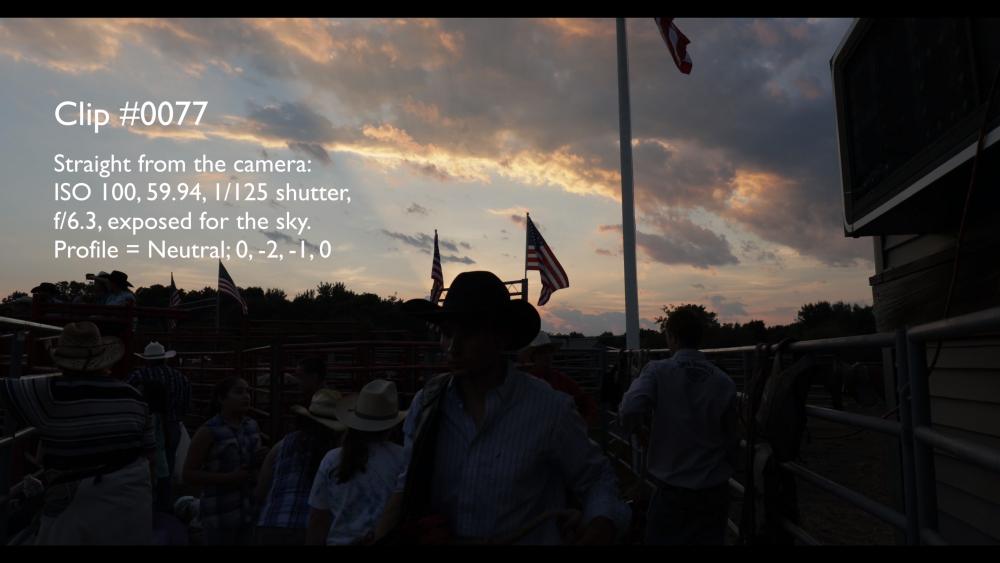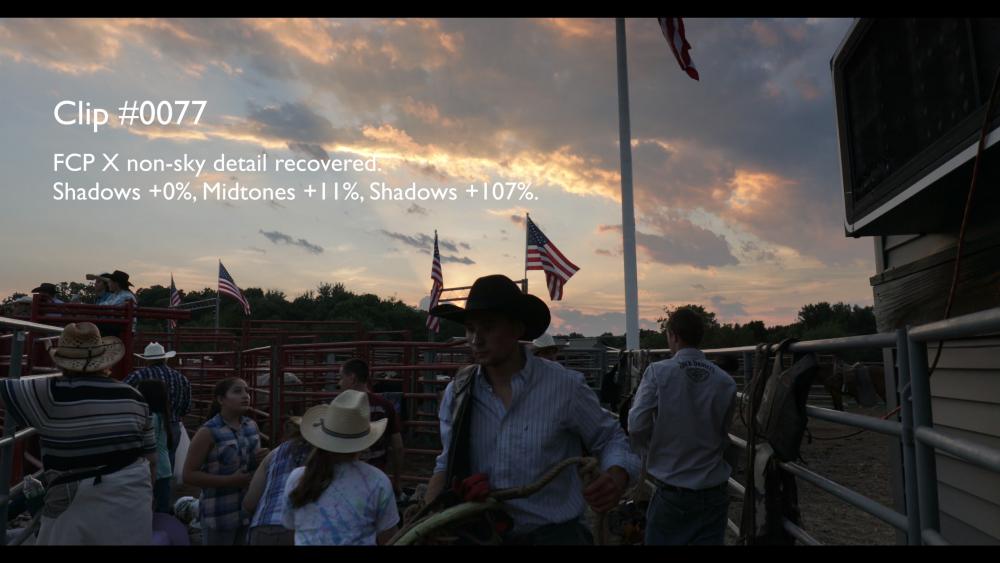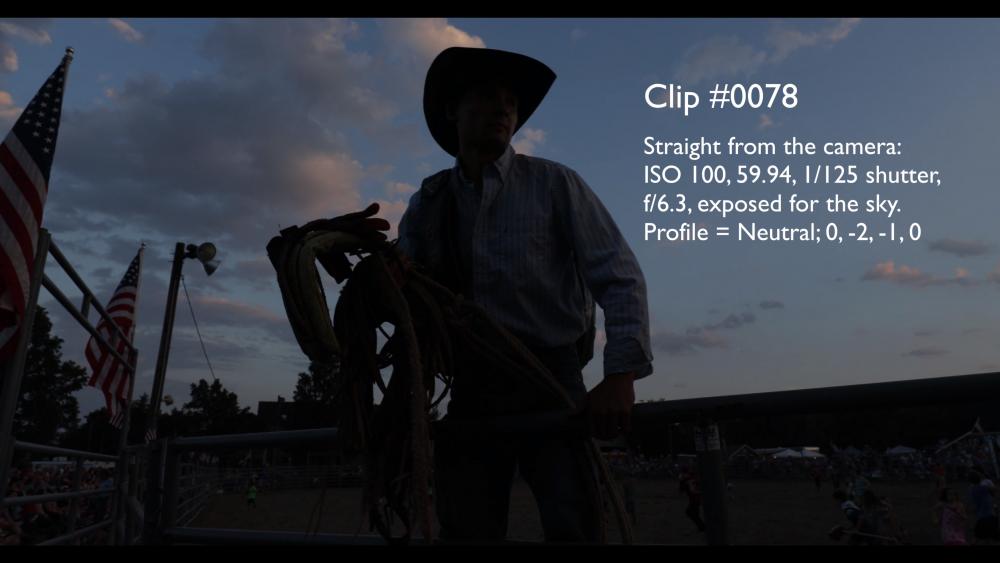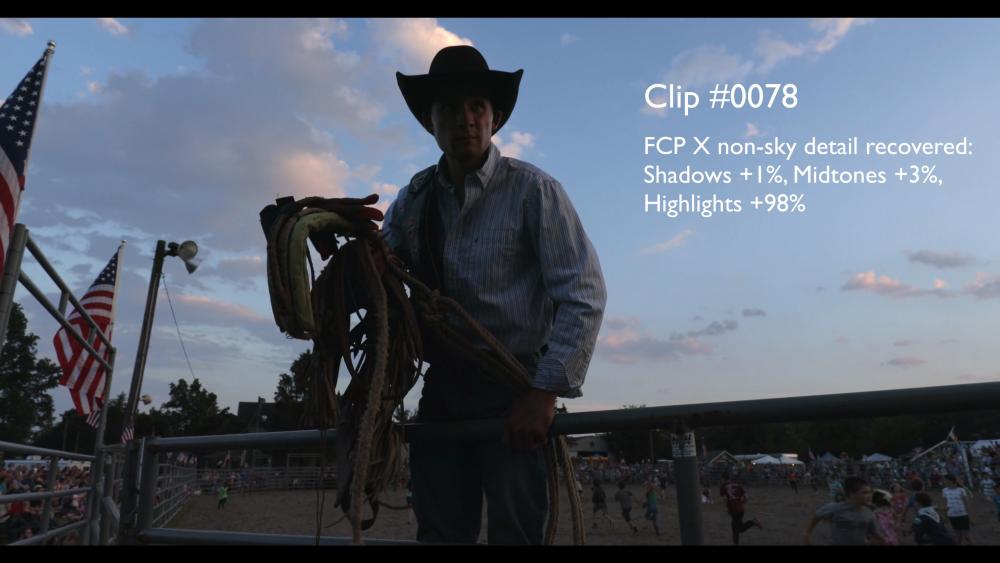
Kino
Members-
Posts
256 -
Joined
-
Last visited
Content Type
Profiles
Forums
Articles
Everything posted by Kino
-
1.74x - A Crop Odyssey - Canon 5D Mark IV officially announced
Kino replied to Andrew - EOSHD's topic in Cameras
He, he! I'm thinking more about $8,000, or the price point just evacuated by the 1DC. -
1.74x - A Crop Odyssey - Canon 5D Mark IV officially announced
Kino replied to Andrew - EOSHD's topic in Cameras
This all but confirms that the 1DC II will be announced by the end of the year to ship in 2017. -
It has nothing to do with the 5D IV, which will come in at a much lower price. Rather, it keeps the 1DC competitive with the 1DX II and makes room for a 1DC II announcement perhaps later this year.
-
The Raven has only the fixed Standard OLPF. There are no other options. I don't have too much of a problem with the skin tones in the above video as it fits the aesthetics of advertising. No doubt, the Raven sensor is capable of more natural skin tones: What did impress me with the Allure video as opposed to the Raven footage that was posted previously was how clean the footage was in comparison. There is no noise and the ISO is kept well within the Dragon's range.
-
I saw some examples of RED Raven footage posted above, but I think this video is a much better demonstration of the camera's potential: For $5-10K, it doesn't get much better than this in terms of image quality. If you are shooting events or docs, however, I'm sure a Canon or Sony would be a better choice.
-
Rep vs. Specialist is just semantic nonsense. Wasim Ahmad has indeed been Canon's main rep when it comes to the 1DX II release. He has been its main spokesman at every major video/photo event since before the release, including NAB 2016. Roger Machin is just a regional Canon rep and nothing more. You can choose to believe whoever you want. The reality is that the 1DX II does not have any prospect for a "firmware upgrade" that adds C-Log or any of the other exclusive 1DC cinema features. I have no idea how much a hypothetical 1DC II will cost, but, if it improves on the original, it will be worth every penny in my opinion. As it is, the 1DC is a magnificent camera with image quality unmatched by anything out there in the DSLR world. A 1DC II will be a dream camera for many.
-
The Roger Machin reference to the 1DX II "replacing" the 1DC is something we have discussed on here before. It's just an off-the-cuff remark by a Canon regional rep for SA and not Canon's official position. Canon's main rep on the 1DX II, Wasim Ahmad, has stated the exact opposite with regard to the 1DC and 1DX II as "separate lines." Given that the C500 and 1DC are both massively discounted from their original prices, I suspect those two models are going to be replaced by newer models in the near future. If Canon does announce a 1DC II, it will come after the 1DX II sales have been mostly exhausted. I'm sure it will be nearly identical to the 1DX II, but will add a few features from the 1DC that are intentionally missing. I would bet far more on a 1DC II with C-Log than the idea of the 1DX II getting C-log out of nowhere. Canon just doesn't work like that. We all know that C-Log is exclusive to the Cinema EOS line and camcorders like the XC10 (which is under the same cinema/video division).
-
Congrats on your 1DC. It's an awesome camera that is often overlooked. As for those two films, I believe only Knock Knock was shot on the 1DC. It doesn't matter though. The 1DC has produced spectacular imagery in many high-end productions for film and TV. Best of all, no one suspects that you have a 4K cinema camera in your little tourist camera bag!
-
Hurlbut on shooting in C-Log on the 1DC: "Canon Log was one of the most exciting functions of the 1DC. At 400 ISO, it will give you a dynamic range of 12.5 stops. The log looks unbelievable. You can expose it easily, not like Cinestyle or other flat files. No h.264 codec here. This records to motion jpegs, and the WOW factor goes up when you see how the slight compression to the cards makes it look just like film. This compression, that I have embraced and love, softens the highlights, skin and rounds the 4K capture. The contrast ratio feels more like a hill than a cliff. Skin tones are absolutely beautiful. Vitality abounds with the Canon’s sensor and color space. I could care less that it is 8 BIT color. I am getting it very close, and Dave Cole, our colorist at Technicolor, had a huge range to deal with. Canon’s 8 BIT feels like 12 BIT with its color space and reproduction." http://www.thehurlblog.com/film-education-online-the-next-gen-in-digital-film-capture-canons-4k-1dc/ Hurlbut also got only 9 stops shooting without C-log on the 1DC, so a difference of over 3 stops. Of course, you could argue that MJPEG plays a significant part in the 1DC's overall image quality, but it is the combination of MJPEG (4:2:2) and C-Log that facilitates the enhanced color grading possibilities in post. Moreover, the color space doesn't have to be any different for you to notice the greater flexibility in color grading that log provides over neutral.
-
It's much easier to get a smooth highlight roll-off from C-Log and the color gamut has a broader range to work with in post. This was already noted by a Technicolor colorist when grading Hurlbut's 1DC footage a few years ago. All the same, the above test shows that the 1DX II is not lacking in overall dynamic range. It has tremendous capability and incredibly clean shadows. I think if you already have a 1DC, you can look past the 1DX II. But if you are new to the 1D series cameras, the 1DX II offers good value among Canon's 4K options.
-
Yes, I remember commenting on that thread in favor of your 1DC results: It was a very useful test. One thing I would like to have seen is shadow comparisons between the 1DC in C-Log and the 1DX II. I believe the ones you provided were 1DC Neutral vs. 1DX II, whereas the highlight test looked at 1DC C-Log vs. 1DX II Neutral. C-Log is not always the best for clean shadows on the 1DC. What I'm seeing in pretty much all the 1DX II footage is much cleaner shadows than the 1DC in C-Log. The highlight roll-off might be more difficult to match, but the overall DR is very similar as portrayed in Cinema5d's Xyla test, where the DR is derived from Imatest software. The Roemer video above speaks for itself. It's an amazing performance for the 1DX II or any DSLR for that matter. A lowlight, portable and weather-sealed camera with 4K 60p and DPAF (and great rolling shutter performance) would be a nice complement to what I already have.
-
Here is a really impressive demonstration of shadow recovery on the 1DX II (video and blog by Jon Roemer): I can start to see how Cinema5d got similar overall DR numbers in its testing of the 1DC and 1DX II. If you expose for the highlights, you have a lot to work with in the shadows and midtones before hitting visible noise levels.
-
The Blackmagic 4K sensor has a global shutter and a resulting motion cadence that is very filmic in my opinion. It's a very unique quality to have in such a cheap camera, as it cost me $2500 brand new (and comes with a full version of Resolve, which is a $1000 added value). My unit also has no FPN that I've noticed after shooting ISO 800 in pitch black, but I'm aware that others have had nasty FPN problems. Regardless of the presence or absence of FPN, it is not a low-light camera as the ISO range and sensitivity are lower than any DSLR. Now Version 2 of the 4K sensor in the UM 4K has solved the black sun problem, but quality control and FPN issues persist. BMD has the worst quality control of any camera manufacturer as is well established by now (their post-production products on the other hand are much better). As for dynamic range, all I can say is that the Cinema DNG files are a goldmine of highlight and shadow recovery like you wouldn't believe. Whatever DR you start with, I would say you could get another 2-3 stops by grading the BMPC-4K's RAW files in Resolve. I don't shoot with the GH4 or V-Log so I'm not sure how it would compare really. You would have to put them side-by-side in Resolve to get a good idea of the usable DR. Finally, the lack of an anti-aliasing filter on the BMD cameras is a double edged sword: on the one hand, it means greater resolving power; on the other, you will get some aliasing and moiré (which is pretty minimal in my experience). RED by contrast employs very aggressive AA in their OLPFs that leads to a loss of fine detail, but gives the image a softer and more filmic appearance straight out of the camera. When I compare footage from Raven and Scarlet-W with BMPC-4K files, I see more resolution in the BMPC-4K than the Raven at 4.5K. The Scarlet-W is much better than the Raven since it shoots at 5K, yet still very close to the BMPC-4K. Of course, this is to say nothing of Raven's superior color science, its built-in IR filtration, its modularity and portability, its more efficient R3D codec, and its ability to shoot 4K in higher frame rates than the Ursa Mini cameras. If you have the money, by all means forget BMD and go with RED.
-
From what many have suggested here, you can see that the C100 is an ideal documentary and event video camera, but it's not really in the same class as the RAW cinema cameras from Blackmagic. I shoot with the BMPC-4K and am always amazed by what I can get out of the Cinema DNG RAW files in post. It's pretty incredible the DR and colors that you have to work with in Resolve. As for the UM 4.6k, I would wait until they have solved all the problems. By that point, the Terra 5K footage should be out so you can decide between those two cinema cameras if that is the road you want to go down. Personally, I cancelled my UM 4.6k order before it shipped since the footage that I was seeing had a few problems, including the motion cadence, color science, highlight clipping (the roll-off is not very smooth), and the absence of the global shutter that was promised. I also feel like I dodged a bullet, since we have reports of dealers going through 3-4 cameras to find a good one without any issues. At the moment, I don't believe they are even shipping the UM 4.6k as they wait to fix the camera. Now having listed a few things I don't like about some of the UM 4.6k footage I have seen out there, there is no doubt that it can produce astounding or breathtaking results: This would go on my list as some of the most beautiful and "filmic" imagery I have seen from any digital video camera all year.
-
Exactly. The cheapest I've seen it is around $8-9K: https://www.lensauthority.com/products/canon-eos-c500-ef-camcorder?gclid=CJHT3o37qs0CFdgXgQod_FYDAQ If you really want a C500, it's best to buy it new for $10K and get the warranty and the Cinema EOS services. There are too many things that can go wrong with a high-end cinema camera. It's a huge investment that you will need to count on over the years.
-
1DX II colors and skin tones "straight out of the camera": Good example of smooth and creamy roll-off here. Those picture style settings have a significant affect on color and DR. The number of looks you can achieve with the 1DX II are endless.
-
To be honest, the more footage I see from the 1DX II, the more I think it doesn't really need C-Log at all. There are a lot of excellent picture styles and post-processing looks out there already for every kind of filmic grade that you may want. Here are just a few examples that impressed me: Moreover, the 1DX II footage is some of the cleanest I have ever seen from a 4K camera, let alone anything that Canon has produced in its Cinema EOS line: On 4K image alone, it is a threat to the C100 II (no 4K), C300 II (overpriced), C500 (no internal 4K), UM 4.6k (would not have one for free), FS7 (XAVC-I is highly compressed at 240 Mbps), and even the Raven (too much noise) that I have ordered, all of which I would pass on to buy this camera. When I need XLRs, I attach a separate audio preamp/recorder with a line into the camera. It's really not a problem and generally better than what you get from in-camera XLRs on a dedicated video camera. I would have to do the same thing with the Raven, for example, as the XLR module costs an extra $3K.
-
I'm very interested in your results with Marvels Cine Picture Style on the 1DX II specifically. Do you have any samples that you can post that demonstrate enhanced DR performance or roll-off relative to the standard or neutral profiles? All the Marvels samples online are with other Canon cameras. Also, I believe C-Log has access to RAW sensor data before the point at which picture profiles are ever involved. I guess only the Canon engineers know for sure. One thing we do know is that if the $6,000 1DX II had C-Log it would seriously threaten the entire Cinema EOS line. It may be that they have no plans for a 1DC II, such that their main objective here is simply to protect the overpriced C300 II and whatever 4K C200/C100 III they plan to release.
-
Canon 5D Mark IV spotted on Red Bull sponsored surf shoot
Kino replied to Andrew - EOSHD's topic in Cameras
"The wind-surfing quite possibly suggests Dual-Pixel AF will play a big part of the new marketing campaign . . ." DPAF on the 5D! Nice, but still no MJPEG codec probably. 5D body is no match for 1D heat management, recording data rate, and processing power. At least Canon is working on new models. I hope the 1DC II is next, along with the C500 II or C200/C100 III. -
4K RAW 120fps for £3k?! Say hello to the second-hand Canon C500
Kino replied to Andrew - EOSHD's topic in Cameras
Is the Terra really "out this year" and how many? I have trouble believing such a small company will be able to ship in large numbers. The 6K also suffers from the worst rolling shutter you have ever seen unless you shoot it in "sport mode" and a lower resolution. And what about warranty service with Kinefinity. Does it have to go back to China every time something goes wrong? I'm certainly intrigued by the Terra 5K with its switchable global shutter. I currently have a Raven on order (which I might switch to the Scarlet-W for the 5K). The only thing that would make me reconsider is if Kinefinity announced a U.S. distributor or if Canon announced the 1DC II. While I love the C500, the available recorders may be too large of an addition for the type of portability I am looking for in a 4K camera. With all the wires going everywhere and a big screen attached to the camera, it may become a little unwieldy. -
4K RAW 120fps for £3k?! Say hello to the second-hand Canon C500
Kino replied to Andrew - EOSHD's topic in Cameras
Thanks for the review. I look forward to your findings with 4K going to the Odyssey as well as how you intend to setup your rig. I do love the image from the C500, even though it may not have the same DR as some other cinema cameras. It's also one of the best low-light performers out there as you mention. I think there is a good reason for that. It has a larger than average 35mm sensor (26.2 x 13.8mm) with huge photosites (6.4 µm) compared with competing cinema cameras from RED, Sony and Blackmagic. It simply collects more light and can provide a better signal-to-noise ratio than many of these other cinema cameras. -
I thought that C-Log must be shot at ISO 400 or above to avoid banding on the 1DC. ISO 800 was probably chosen for what they thought may be the best performance, but it does seem slightly odd considering the fact that they had to use different apertures. As for the rolling shutter, they claim the 1DX II achieves an incredible number: 14ms. I do agree that the Xyla test is questionable considering everything we have seen from these two cameras. It also does not demonstrate the highlight roll-off of the cameras and is more informative for what is going on in the shadows (where C-Log is also preserving more color information based on other tests we have discussed here). And, yes, of course, Cinestyle is no real substitute for C-Log on the 1DC for reasons I have already stated (no access to RAW sensor data like C-Log). However, we should also not forget that filmmakers like Abraham Joffe have shot beautiful footage on the 1DC without using C-Log: In fact, Joffe has stated that he prefers shooting the 1DC using the picture profile settings and not C-Log: http://www.untitledfilms.com.au/2013/11/shoot-edit-deliver-4k-now/ You can check out all his 1DC films including the National Geographic TV series, Tales By Light, to get an idea of what is possible outside of C-Log: Now if I owned a 1DC, I'm sure I would use C-Log for most situations, but it doesn't mean that great results are not possible without it or that it is ideal for every lighting condition. C-Log or not, the 1DC is just a magical camera.
-
That is awesome. Thanks for posting. It's obvious those first four bars are clipped on standard gamma, whereas only two are clipped on C-Log. The distribution of the stops is also very different: C-Log provides a much greater "usable" range (10 stops vs. 8 stops). Again, for me the 1DC footage looks like it came from a high-end cinema camera (and is often used alongside such cameras), whereas the 1DX II just has too much contrast to cut with such cameras.
-
I agree that in the footage we have seen thus far, the 1DX II has much more contrast and has nowhere near the same highlight roll-off as the 1DC. At the end of the day, I don't care about Xyla tests as much so I have no idea why the DR is exactly the same here: the 1DC just has a very different and much more appealing look to me. As you suggest, the results may be due to a flawed testing methodology. I just want to see 1DX II footage that demonstrates the DR results in this Cinema5d test because I'm not seeing it in the 1DX II videos. Perhaps it has to do with the way the DR is distributed in the 1DX II since it does not have the same DR as the 1DC in the highlights. C-Log is also able to access RAW sensor data in a way that Technicolor Cinestyle does not, so there should be a significant difference between them as there is on the 1DC itself, where neutral and Log show about 3-4 stops of DR difference. This difference is especially evident in the highlights:
-
I posted this amazing Xyla on the other thread not knowing you had already posted it here. Anyway, the reason for the different apertures is because the 1DX II has better ISO performance and thus the 1DC needs to open up for more light on the Xyla test. Moreover, ISO 800 is chosen to maximize the DR performance on both cameras. With Technicolor Cinestyle, the 1DX II is thus achieving the exact same DR as the 1DC with C-Log. If I can see some Cinestyle footage from the 1DX II that demonstrates this, it will have saved me thousands of dollars as the 1DX II is also far superior to the 1DC for rolling shutter. It's actually even better than many cinema cameras. I suppose there is no need for C-Log or any "1DC II" when we can install Cinestyle for a similar effect.





